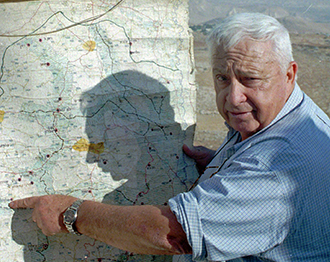

Sharon, in a 1995 photo. (AP)
 |
After all this time, can 'facts on the ground' be overcome?
COMMENTARY | September 273, 2010
In 1980 Ariel Sharon took two Washington Post reporters on a day-long tour in his Land Rover and, map in hand, hilltop by hilltop, told them they were looking at what would be “irreversible facts on the ground.” Now, with West Bank settlements at the crux of Israel-Palestinian negotiations, Bill Claiborne, the Washington Post’s Jerusalem bureau chief at the time, looks back on that prophetic interview.
By William Claiborne
william.claiborne@gmail.com
It was one of the strangest—yet most prophetic—interviews I ever conducted. It was on a hot late summer morning in 1980. I was The Washington Post’s bureau chief in Jerusalem, and I had teamed up with The Post’s Cairo bureau chief, Ed Cody, to do a series of articles that would be entitled “The West Bank: Hostage of History”.
We met up with Ariel Sharon, who then was Israel’s Agriculture Minister, and his driver alongside a Jerusalem highway and climbed into the back seat of the legendary Israeli war hero’s Land Rover. The barrel-chested and gregarious Sharon, who 21 years later would become Israel’s 11th prime minister, greeted us warmly and we set off on a day-long tour of rocky hilltops that Sharon promised would re-chart “an entirely new map of the country.”
Now, consider this: at the time, there were just 72 settlements in the West Bank, most of them relatively small, with a total Jewish population of 14,000, excluding East Jerusalem. During the two years since the signing of the Camp David peace accords, which vaguely had promised a degree of self-governance for 720,000 Palestinian Arabs, I had traveled up and down the West Bank, reporting on the 39 new settlements that had been erected since the Camp David accord. Now Cody and I were about to learn from Sharon just how far Prime Minister Menachem Begin’s government intended to go with that rate of settlement expansion, and for what purpose it was intended.
I can’t speak for Cody, but I, for one, could not have dreamed on that steamy August morning that 30 years later there would be more than 120 officially-recognized Israeli settlements in the West Bank, with a total Jewish population of more than 300,000, excluding East Jerusalem, which has 192,000 Jewish settlers. (These do not include an additional 107 “unauthorized outposts” in the West Bank, many of them covertly assisted by government ministries). Many of the official “settlements” are actually cities of up to 45,000 people, something I could not even imagine at a time when the new outposts consisted largely of prefabricated modular houses or, in many cases, mobile homes.
However, looking back now at what Sharon said to us that day as we drove the length and breadth of the occupied West Bank, exploring his vision of a transformation of the land that some Jews historically have called Judea and Samaria and Arabs have historically called Palestine, I am not surprised at all by what has happened since then in terms of the expansion of Jewish housing in the West Bank and its effects on peace negotiations. And I do look back upon that day often, especially now that the issue of Jewish settlements once again seems to be a major stumbling block in peace negotiations, this time being held between Israeli Prime Minister Benjamin Netanyahu and Palestinian Authority President Mahmoud Abbas.
As we drove down the Allon Road linking a north-south line of Israeli settlements astride a mountainous West Bank ridge overlooking the Jordan Valley, Sharon’s Land Rover would suddenly veer off onto a dirt track leading to one rocky outcrop after another that had been designated as the site of a proposed settlement.
The former general waved a rolled-up Army topographical map at us and, in his high-pitched voice, shouted:
“This map exists. You just can’t do anything about it any more. That is why it is impossible any more to talk about the Jordanian option of territorial compromise. We are going to leave an entirely different map of the country that it will be impossible to ignore. I don’t see any way any government will be able to dismantle the settlements of Judea and Samaria.”
It was unmistakably clear to me that what Sharon meant was that because of its system of low-threshold, party list proportional representation, Israel’s Knesset (parliament), historically has produced unstable coalition governments dependent on the support of orthodox religious parties that are stridently pro-settlement. These parties often hold the balance of power in the Knesset, and consequently any government that attempts to dismantle settlements would almost certainly collapse under a no-confidence vote.
“Irreversible facts on the ground.” That phrase by Sharon haunts me every time a new round of peace talks generates at least a modicum of optimism, like that currently being voiced by President Barrack Obama and Secretary of State Hilary Clinton. I would like to be optimistic, too, because it saddens me that neither the Israelis nor the Palestinian Arabs will ever find peace and security until they find a way to co-inhabit in the land that each claims as their right.
Sharon’s comments that day were important because it was the first time that such a high-level Israeli policymaker had so candidly articulated a long-range strategy of using a network of Jewish settlements as a political device for precluding any possibility of returning occupied territory in the West Bank. No Israeli government could ever dismantle the outposts and survive the inevitable political backlash, the strategy suggested – and it has held true ever since.
Until that time, the publicly-declared justifications of various Israeli governments for building settlements in the West Bank had been largely based on Jews’ historical right to live on land that was promised to them in a covenant between God and Abraham. Only during the months preceding our interview with Sharon had the emphasis begun to shift to the West Bank’s importance to the security of the Jewish state.
In any case, the notion that, because of the political realities within Israel, settlements would preclude the possibility of territorial compromise and the creation of a Palestinian state was practically unheard of at that time, at least coming from a top government official and future prime minister. That was why Cody and I exchanged astonished glances at each other as Sharon charged up one hilltop after another, waving his rolled-up map and shouted things like, “I believe in things that are done, in facts that are created.”
Now, I am well aware that Sharon, who today lies hospitalized in a permanent vegetative state after suffering a series of strokes in 2006, is the man who forcibly removed Jewish settlers from their homes in Yamit, in the Israeli-occupied Sinai Peninsula, and who later did the same thing in the Gaza Strip. I was in Yamit on April 23, 1982, when Sharon sent bulldozers into the city of 2,500 Israelis and literally plowed it into the ground while soldiers dragged away settlers who had barricaded themselves on rooftops. Later, in 2005, Sharon forced thousands of settlers out of their homes and farms in the Gaza Strip.
But neither the Sinai, which Israel returned to Egypt in exchange for a peace treaty, nor Gaza, whose settlements Sharon dismantled as part of his unilateral “disengagement” plan in 2005, were issues nearly as volatile as those surrounding the West Bank settlements. Most secular Israelis were ambiguous, at best, about the eviction of the Sinai and Gaza settlers, and the likelihood of a government collapsing over the evictions was remote compared to the certainty of what the forced removal of nearly half a million Jewish settlers from the West Bank would precipitate.
What is new this time around, however, is the possibility of land swaps between Israel and the Palestinian Authority that would trade sections of Israel where many of its 1 million Arab citizens live for some West Bank Jewish settlements as part of any peace deal. Israel’s hawkish Foreign Minister Avigdor Lieberman recently discussed such land swaps, which resemble in some aspects a plan proposed two years ago by former Prime Minister Ehud Olmert but rejected by the Palestinians.
In a recent lecture in Tel Aviv, Olmert said that if current peace talks are to succeed, the agreement would have to resemble the land swap plan he proposed in 2008, which he said would give Palestinians an independent state on more than 90 per cent of the West Bank. However, for now Netanyahu has taken such a compromise off the table.
I don’t know if Israeli and Palestinian negotiators could ever agree on what amounts to an exchange of land and people. It would be an enormously complex arrangement and the devil would certainly be in the details. I also don’t know if the two sides can reach an agreement on the status of Jerusalem’s coveted Old City, sacred to both sides, or on the repatriation of Palestinians who lost their homes in the fighting around Israel’s creation. I hope that all of these seemingly intractable issues—and more yet to be addressed—can be resolved and peace at last comes to this troubled part of the world.
I also don’t know what Arik Sharon might say about Jewish settlements in the West Bank if he were able to speak today. But I do know, or at least believe very firmly, that the settlement issues are not going to just go away.
They are, as Sharon said, facts on the ground.
|
|
Bill Claiborne, now living in Australia, was a Washington Post reporter for 32 years, mostly in foreign and national news positions. 
E-mail: william.claiborne@gmail.com
|
|
|
|
|





